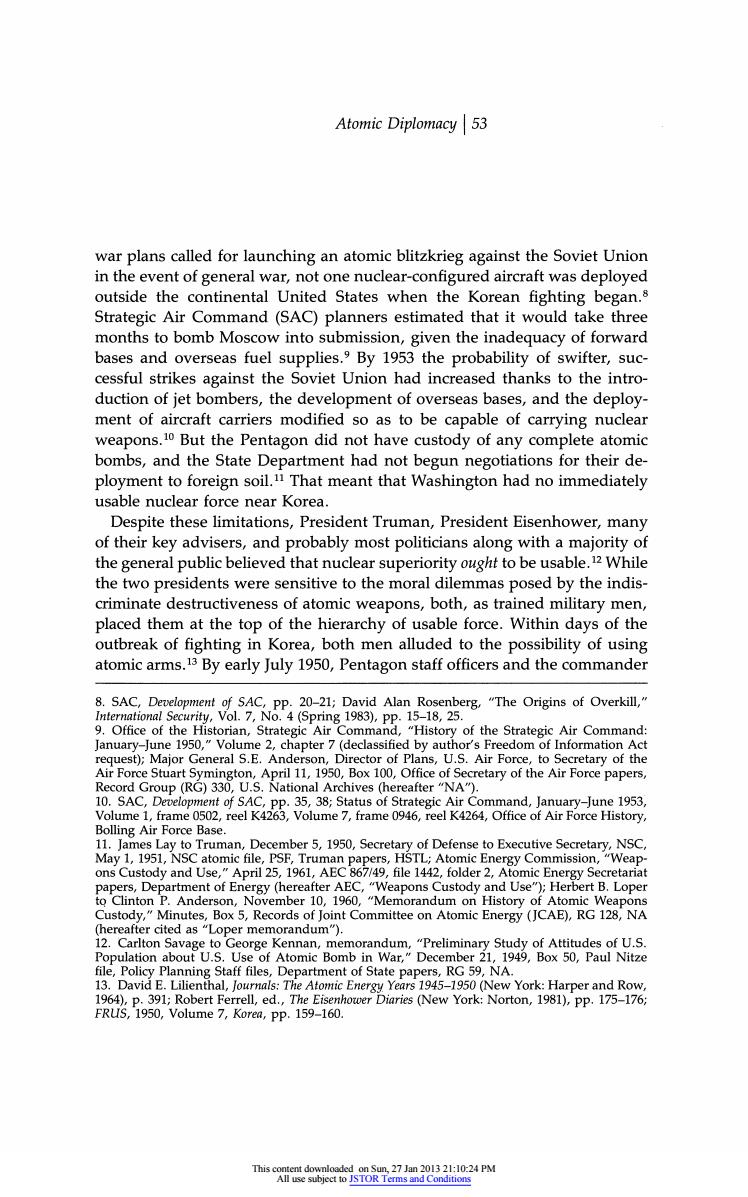正在加载图片...

Atomic Diplomacy 53 war plans called for launching an atomic blitzkrieg against the Soviet Union in the event of general war,not one nuclear-configured aircraft was deployed outside the continental United States when the Korean fighting began.s Strategic Air Command(SAC)planners estimated that it would take three months to bomb Moscow into submission,given the inadequacy of forward bases and overseas fuel supplies.9 By 1953 the probability of swifter,suc- cessful strikes against the Soviet Union had increased thanks to the intro- duction of jet bombers,the development of overseas bases,and the deploy- ment of aircraft carriers modified so as to be capable of carrying nuclear weapons.10 But the Pentagon did not have custody of any complete atomic bombs,and the State Department had not begun negotiations for their de- ployment to foreign soil.11 That meant that Washington had no immediately usable nuclear force near Korea. Despite these limitations,President Truman,President Eisenhower,many of their key advisers,and probably most politicians along with a majority of the general public believed that nuclear superiority ought to be usable.12 While the two presidents were sensitive to the moral dilemmas posed by the indis- criminate destructiveness of atomic weapons,both,as trained military men, placed them at the top of the hierarchy of usable force.Within days of the outbreak of fighting in Korea,both men alluded to the possibility of using atomic arms.13 By early July 1950,Pentagon staff officers and the commander 8.SAC,Development of SAC,pp.20-21;David Alan Rosenberg,"The Origins of Overkill," International Security,Vol.7,No.4(Spring 1983),pp.15-18,25. 9.Office of the Historian,Strategic Air Command,"History of the Strategic Air Command: January-June 1950,"Volume 2,chapter 7(declassified by author's Freedom of Information Act request);Major General S.E.Anderson,Director of Plans,U.S.Air Force,to Secretary of the Air Force Stuart Symington,April 11,1950,Box 100,Office of Secretary of the Air Force papers, Record Group (RG)330,U.S.National Archives (hereafter "NA"). 10.SAC,Development of SAC,pp.35,38;Status of Strategic Air Command,January-June 1953 Volume 1,frame 0502,reel K4263,Volume 7,frame 0946,reel K4264,Office of Air Force History, Bolling Air Force Base. 11.James Lay to Truman,December 5,1950,Secretary of Defense to Executive Secretary,NSC May 1,1951,NSC atomic file,PSF,Truman papers,HSTL;Atomic Energy Commission,"Weap- ons Custody and Use,"April 25,1961,AEC 867/49,file 1442,folder 2,Atomic Energy Secretariat papers,Department of Energy(hereafter AEC,"Weapons Custody and Use");Herbert B.Loper to Clinton P.Anderson,November 10,1960,"Memorandum on History of Atomic Weapons Custody,"Minutes,Box 5,Records of Joint Committee on Atomic Energy(JCAE),RG 128,NA (hereafter cited as "Loper memorandum"). 12.Carlton Savage to George Kennan,memorandum,"Preliminary Study of Attitudes of U.S. Population about U.S.Use of Atomic Bomb in War,"December 21,1949,Box 50,Paul Nitze file,Policy Planning Staff files,Department of State papers,RG 59,NA. 13.David E.Lilienthal,Journals:The Atomic Energy Years 1945-1950(New York:Harper and Row, 1964),p.391;Robert Ferrell,ed.,The Eisenhower Diaries (New York:Norton,1981),pp.175-176; FRUS,1950,Volume 7,Korea,pp.159-160. This content downloaded on Sun,27 Jan 2013 21:10:24 PM All use subject to JSTOR Terms and ConditionsAtomic Diplomacy |53 war plans called for launching an atomic blitzkrieg against the Soviet Union in the event of general war, not one nuclear-configured aircraft was deployed outside the continental United States when the Korean fighting began.8 Strategic Air Command (SAC) planners estimated that it would take three months to bomb Moscow into submission, given the inadequacy of forward bases and overseas fuel supplies.9 By 1953 the probability of swifter, successful strikes against the Soviet Union had increased thanks to the introduction of jet bombers, the development of overseas bases, and the deployment of aircraft carriers modified so as to be capable of carrying nuclear weapons.10 But the Pentagon did not have custody of any complete atomic bombs, and the State Department had not begun negotiations for their deployment to foreign soil.11 That meant that Washington had no immediately usable nuclear force near Korea. Despite these limitations, President Truman, President Eisenhower, many of their key advisers, and probably most politicians along with a majority of the general public believed that nuclear superiority ought to be usable. 12 While the two presidents were sensitive to the moral dilemmas posed by the indiscriminate destructiveness of atomic weapons, both, as trained military men, placed them at the top of the hierarchy of usable force. Within days of the outbreak of fighting in Korea, both men alluded to the possibility of using atomic arms.13 By early July 1950, Pentagon staff officers and the commander 8. SAC, Development of SAC, pp. 20-21; David Alan Rosenberg, "The Origins of Overkill," International Security, Vol. 7, No. 4 (Spring 1983), pp. 15-18, 25. 9. Office of the Historian, Strategic Air Command, "History of the Strategic Air Command: January-June 1950," Volume 2, chapter 7 (declassified by author's Freedom of Information Act request); Major General S.E. Anderson, Director of Plans, U.S. Air Force, to Secretary of the Air Force Stuart Symington, April 11, 1950, Box 100, Office of Secretary of the Air Force papers, Record Group (RG) 330, U.S. National Archives (hereafter "NA"). 10. SAC, Development of SAC, pp. 35, 38; Status of Strategic Air Command, January-June 1953, Volume 1, frame 0502, reel K4263, Volume 7, frame 0946, reel K4264, Office of Air Force History, Bolling Air Force Base. 11. James Lay to Truman, December 5, 1950, Secretary of Defense to Executive Secretary, NSC, May 1, 1951, NSC atomic file, PSF, Truman papers, HSTL; Atomic Energy Commission, "Weapons Custody and Use," April 25, 1961, AEC 867/49, file 1442, folder 2, Atomic Energy Secretariat papers, Department of Energy (hereafter AEC, "Weapons Custody and Use"); Herbert B. Loper tQ Clinton P. Anderson, November 10, 1960, "Memorandum on History of Atomic Weapons Custody," Minutes, Box 5, Records of Joint Committee on Atomic Energy (JCAE), RG 128, NA (hereafter cited as "Loper memorandum"). 12. Carlton Savage to George Kennan, memorandum, "Preliminary Study of Attitudes of U.S. Population about U.S. Use of Atomic Bomb in War," December 21, 1949, Box 50, Paul Nitze file, Policy Planning Staff files, Department of State papers, RG 59, NA. 13. David E. Lilienthal, Journals: The Atomic Energy Years 1945-1950 (New York: Harper and Row, 1964), p. 391; Robert Ferrell, ed., The Eisenhower Diaries (New York: Norton, 1981), pp. 175-176; FRUS, 1950, Volume 7, Korea, pp. 159-160. This content downloaded on Sun, 27 Jan 2013 21:10:24 PM All use subject to JSTOR Terms and Conditions